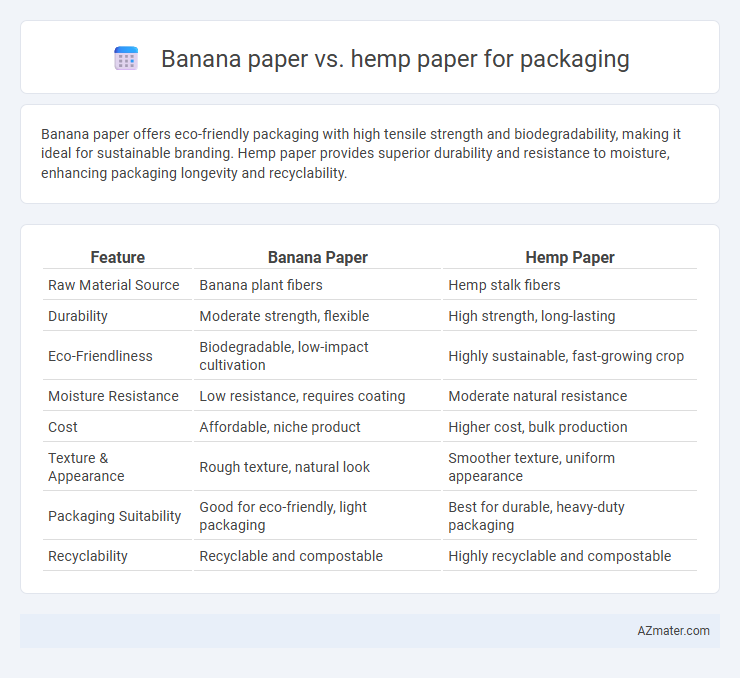Banana paper offers eco-friendly packaging with high tensile strength and biodegradability, making it ideal for sustainable branding. Hemp paper provides superior durability and resistance to moisture, enhancing packaging longevity and recyclability.
Table of Comparison
| Feature | Banana Paper | Hemp Paper |
|---|---|---|
| Raw Material Source | Banana plant fibers | Hemp stalk fibers |
| Durability | Moderate strength, flexible | High strength, long-lasting |
| Eco-Friendliness | Biodegradable, low-impact cultivation | Highly sustainable, fast-growing crop |
| Moisture Resistance | Low resistance, requires coating | Moderate natural resistance |
| Cost | Affordable, niche product | Higher cost, bulk production |
| Texture & Appearance | Rough texture, natural look | Smoother texture, uniform appearance |
| Packaging Suitability | Good for eco-friendly, light packaging | Best for durable, heavy-duty packaging |
| Recyclability | Recyclable and compostable | Highly recyclable and compostable |
Introduction: Eco-Friendly Packaging Alternatives
Banana paper and hemp paper are sustainable packaging alternatives that reduce environmental impact by utilizing renewable plant fibers. Banana paper, made from banana stems, offers biodegradability and strong fiber content, while hemp paper is known for durability and fast growth cycle, making both eco-friendly options for reducing reliance on traditional wood pulp. These materials contribute to lower carbon footprints and support waste reduction in packaging industries.
What is Banana Paper?
Banana paper is an eco-friendly alternative made from the fibers of banana plant pseudostems, offering a sustainable solution in packaging production. Its durability and biodegradable nature make it suitable for various packaging applications, reducing reliance on traditional wood-based paper and plastic materials. Compared to hemp paper, which is derived from hemp fibers known for strength and recyclability, banana paper provides a unique texture and environmental benefit by utilizing agricultural waste from banana cultivation.
What is Hemp Paper?
Hemp paper is an eco-friendly packaging material derived from the fibers of the hemp plant, known for its durability, biodegradability, and resistance to tearing compared to traditional wood-based paper. It boasts a lower environmental impact due to hemp's rapid growth cycle and minimal need for pesticides, making it a sustainable alternative for packaging solutions. Its natural strength and high cellulose content ensure that hemp paper packaging offers superior protection while supporting greener supply chains.
Sustainability Comparison: Banana vs Hemp
Banana paper and hemp paper both offer sustainable alternatives to traditional wood-based packaging, with banana paper utilizing agricultural waste from banana plants, reducing landfill waste and promoting circular economy practices. Hemp paper demonstrates superior sustainability through faster growth cycles, higher carbon sequestration rates, and lower water consumption compared to banana plants, making it an eco-friendlier choice for large-scale packaging production. While banana paper excels in waste valorization, hemp paper's environmental footprint benefits from its regenerative cultivation, positioning hemp as the more sustainable option in packaging materials.
Material Strength and Durability
Hemp paper exhibits superior material strength and durability compared to banana paper, making it ideal for heavy-duty packaging applications. The long fibers in hemp provide enhanced tear resistance and longevity, ensuring better protection during shipping and handling. In contrast, banana paper, while eco-friendly and biodegradable, tends to be less robust and more prone to wear, suitable for lighter packaging needs.
Printability and Usability in Packaging
Banana paper offers excellent printability with smooth texture, enabling high-quality color and detail reproduction ideal for vibrant packaging designs. Hemp paper provides superior durability and resistance to moisture, making it highly usable for eco-friendly packaging that demands strength and longevity. Both papers support sustainable practices, but banana paper excels in visual impact while hemp paper prioritizes robustness and environmental resilience.
Environmental Impact: Production and Disposal
Banana paper production utilizes agricultural waste from banana plants, reducing deforestation and lowering carbon emissions compared to traditional wood-based paper. Hemp paper, derived from fast-growing hemp fibers, offers high yield per acre and requires fewer pesticides, minimizing soil degradation and water usage. Both materials are biodegradable and compostable, but banana paper typically has a shorter decomposition time, making it especially advantageous for sustainable packaging disposal.
Cost and Commercial Availability
Banana paper generally costs less than hemp paper due to lower raw material processing expenses and readily available banana fiber from agricultural waste. Hemp paper offers superior durability and eco-friendliness but tends to be pricier with limited commercial availability, often sourced from niche or specialty suppliers. For large-scale packaging, banana paper provides a more cost-effective solution with wider market accessibility, while hemp paper remains a premium option targeting sustainable packaging segments.
Consumer Perceptions and Market Trends
Banana paper and hemp paper are gaining traction in sustainable packaging due to their eco-friendly properties and biodegradability, with consumers increasingly favoring items that reduce environmental impact. Market trends indicate a rising demand for banana paper packaging in tropical regions where banana waste is abundant, while hemp paper appeals globally due to its durability and faster growth cycle. Consumer perception highlights hemp paper as a premium, strong alternative, whereas banana paper is often seen as innovative and supportive of waste upcycling, influencing brand reputation and purchasing decisions.
Future Prospects for Banana and Hemp Paper in Packaging
Banana paper and hemp paper both offer sustainable alternatives to traditional packaging materials, with hemp paper showing strong potential due to its rapid growth cycle and high fiber strength, making it ideal for durable packaging. Banana paper, derived from agricultural waste, presents a circular economy advantage by reducing banana plantation residues, appealing to eco-conscious brands seeking biodegradable packaging options. The future of packaging favors these materials as industries prioritize renewable sources and reduced environmental impact, driving innovation in processing techniques to enhance the scalability and cost-effectiveness of banana and hemp paper.

Infographic: Banana paper vs Hemp paper for Packaging
 azmater.com
azmater.com